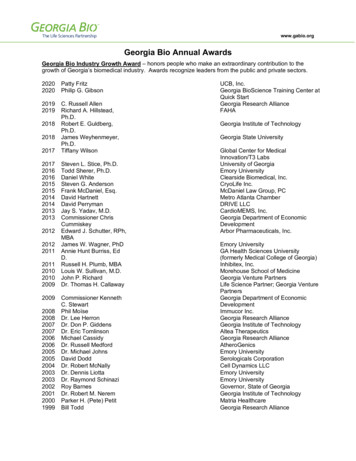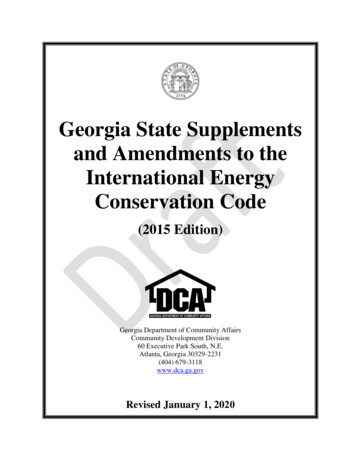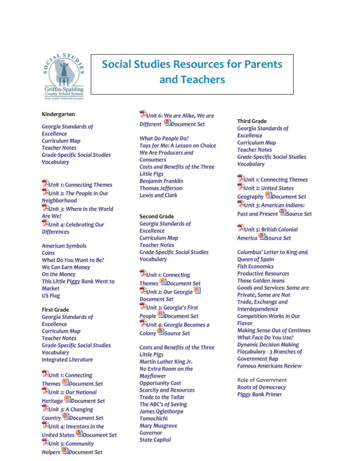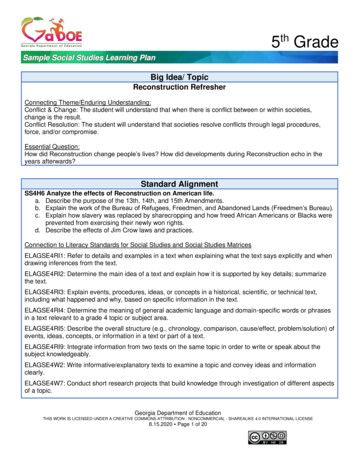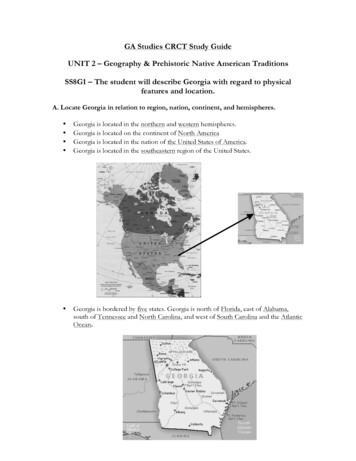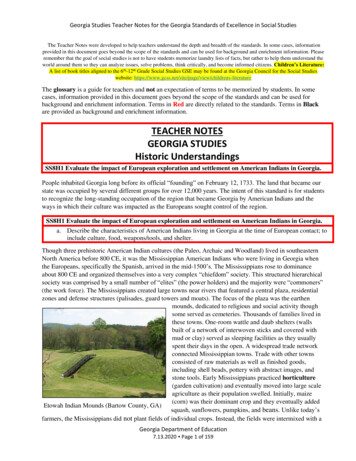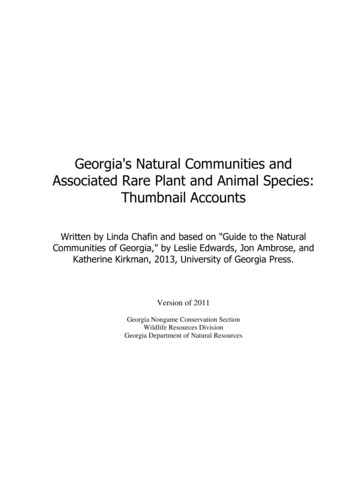
Transcription
Georgia's Natural Communities andAssociated Rare Plant and Animal Species:Thumbnail AccountsWritten by Linda Chafin and based on "Guide to the NaturalCommunities of Georgia," by Leslie Edwards, Jon Ambrose, andKatherine Kirkman, 2013, University of Georgia Press.Version of 2011Georgia Nongame Conservation SectionWildlife Resources DivisionGeorgia Department of Natural Resources
CONTENTSBLUE RIDGE ECOREGIONUpland Forests of the Blue RidgeBlue Ridge northern hardwood and boulderfield forestsBlue Ridge montane oak forestsBlue Ridge cove forests–fertile variantBlue Ridge cove forests–acidic variantBlue Ridge low to mid-elevation oak forestsBlue Ridge pine-oak woodlandsBlue Ridge ultramafic barrens and woodlandsGlades, Barrens, and Rock Outcrops of the Blue Ridge EcoregionBlue Ridge rocky summitsBlue Ridge cliffsBlue Ridge mafic domes, glades, and barrensWetlands of the Blue Ridge EcoregionBlue Ridge mountain bogsBlue Ridge seepage wetlandsBlue Ridge spray cliffsBlue Ridge floodplains and bottomlandsAquatic Environments of the Blue Ridge EcoregionBlue Ridge springs, spring runs, and seepsBlue Ridge small streamsBlue Ridge medium to large riversCUMBERLAND PLATEAU AND RIDGE & VALLEY ECOREGIONSUpland Forests of the Cumberland Plateau and Ridge & Valley EcoregionsCumberland Plateau and Ridge & Valley mesic forestsCumberland Plateau and Ridge & Valley dry calcareous forestsCumberland Plateau and Ridge & Valley dry oak - pine - hickory forestsCumberland Plateau and Ridge & Valley pine - oak woodlands and forestsRidge & Valley and Piedmont longleaf pine forestsRock Outcrops, Prairies, and Barrens of the Cumberland Plateau and Ridge & ValleyEcoregionsRidge & Valley Coosa Valley prairiesRidge & Valley calcareous glades and barrensRidge & Valley acidic glades and barrensCumberland Plateau and Ridge & Valley calcareous cliffsCumberland Plateau and Ridge & Valley acidic cliffsWetlands of the Cumberland Plateau and Ridge & Valley EcoregionsRidge & Valley flatwoodsRidge & Valley calcareous seepage fensCumberland Plateau and Ridge & Valley acidic seepage forests and meadowsCumberland Plateau and Ridge & Valley sag ponds and sinkholesCumberland Plateau and Ridge & Valley floodplains and bottomlandsAquatic Environments of the Cumberland Plateau and Ridge & Valley EcoregionsCumberland Plateau and Ridge & Valley underground streamsCumberland Plateau and Ridge & Valley springs, spring runs, and gravelly seeps
Cumberland Plateau and Ridge & Valley high gradient 1st- and 2nd-order streamsCumberland Plateau and Ridge & Valley streamsCumberland Plateau and Ridge & Valley medium to large riversPIEDMONT ECOREGIONUpland Forests and Woodlands of the Piedmont EcoregionPiedmont mesic forestsPiedmont oak-pine-hickory forestsPiedmont pine-oak woodlands and forestsPiedmont and Ridge & Valley longleaf pine forests and woodlandsPrairies, Glades, Barrens, and Rock Outcrops of the Piedmont EcoregionPiedmont oak-pine prairies and savannasPiedmont glades, barrens, and woodlandsPiedmont granite outcropsPiedmont ultramafic barrens and woodlandsPiedmont cliffs and bluffsWetlands of the Piedmont EcoregionPiedmont upland depression wetlandsPiedmont seeps and springsPiedmont floodplains and bottomlandsAquatic Environments of the Piedmont EcoregionPiedmont rocky or cobbly river shoalsBeaver ponds and freshwater marshesPiedmont streams and riversCOASTAL PLAIN ECOREGIONUpland Forests of the Coastal Plain EcoregionCoastal Plain sandhills and river dunesCoastal Plain Dry Upland Longleaf Pine Forests and WoodlandsCoastal Plain mesic longleaf pine forests and woodlandsCoastal Plain dry evergreen oak forestsCoastal Plain dry deciduous hardwood forestsCoastal Plain mesic slope forestsRock Outcrops, Prairies, and Barrens of the Coastal Plain EcoregionCoastal Plain blackland prairiesCoastal Plain acidic glades, barrens, and rocky woodlandsWetlands and Lowlands of the Coastal Plain EcoregionCoastal Plain pine flatwoodsCoastal Plain seepage slope herb bogsCoastal Plain seepage swamps and shrub bogsCoastal Plain cypress-tupelo river swampsCoastal Plain bottomland hardwood forestsCoastal Plain river bank and levee forestsCoastal Plain small stream floodplain forestsCoastal Plain cypress savannas and depression marshesCoastal Plain cypress-gum depression swampsCoastal Plain oak depression wetlandsCoastal Plain Okefenokee Swamp
Aquatic Environments of the Coastal Plain EcoregionCoastal Plain CavesCoastal Plain Open Water Ponds and LakesCoastal Plain Springs and Spring RunsCoastal Plain Alluvial (Brownwater) Rivers and StreamsCoastal Plain Nonalluvial (Blackwater) Rivers and StreamsCOASTAL ECOREGION: BARRIER ISLANDS AND ADJACENT MAINLANDCoastal Estuarine and Near-shore Marine WatersCoastal Beaches, Sand Bars, and Intertidal FlatsCoastal Maritime DunesCoastal Interdunal WetlandsCoastal Maritime ForestsCoastal Salt and Brackish MarshesCoastal Tidal SwampsCoastal Tidal Freshwater Marshes
BLUE RIDGE ECOREGION
UPLAND FORESTS OF THE BLUE RIDGE ECOREGIONBLUE RIDGE NORTHERN HARDWOOD FORESTS AND BOULDERFIELD FORESTSNorthern hardwood forests are found in Georgia above 3,500 feet, on some cool, moist, north-facingslopes. The tree canopy often includes a large number of deciduous hardwood species, includingyellow birch, American beech, yellow buckeye, white basswood, northern red oak, sugar maple,white ash, and black cherry; low elevation species, such as tulip tree and cucumber magnolia, areunusual or absent. Because of the higher elevation and exposed location, trees in these forests areoften blown over in storms or heavily pruned by ice and snow; the gaps formed when trees aredamaged are sunny patches where shrub and ground layer species flourish, young trees get a headstart, and the forest renews itself. Boulderfields, rocky areas at the heads of high elevation, northfacing coves, also support northern hardwood forests, differing primarily in the greater abundance ofshrub species and the dense mats of mosses covering the tightly packed boulders. Northernhardwood forests are especially interesting in the spring when the ground is carpeted with springephemerals, such as trout lily, Dutchman’s britches, and spring beauty, as well as other springwildflowers, such as trillium, bellwort, umbrella-leaf, and bead lily. Few examples of old-growthnorthern hardwood forest remain in Georgia; these forests, as well as second-growth stands, shouldbe protected from logging, clearing, road-building, fire, and development.Comprehensive Wildlife Conservation Strategy High Priority Habitat: Northern HardwoodForests, Boulderfield ForestsSpecial Concern Plant Species Associated with Blue Ridge Northern Hardwood Forests andBoulderfield Forests:Northern shorthusk grass, BrachyelytrumAmerican false hellebore, Veratrum virideseptentrionaleAmerican fly-honeysuckle, LoniceraPurple giant hyssop, Agastache scrophulariifoliacanadensisRed elderberry, Sambucus racemosa ssp. pubensAmerican mountain-ash, Sorbus americanaRoan Mountain sedge, Carex roanensisBearberry, Vaccinium erythrocarpumRosy twisted-stalk, Streptopus lanceolatusBroad-leaved tickseed, Coreopsis latifoliaRough sedge, Carex scabrataChokecherry, Prunus virginianaSmall purple fringed orchid, Platanthera psycodesFire cherry, Prunus pensylvanicaSpotted coralroot, Corallorhiza maculataHispid hedge-nettle, Stachys hispidaSquirrel-corn, Dicentra canadensisLarge purple fringed orchid, PlatantheraStarflower, Trientalis borealisgrandifloraWhite woodsorrel, Oxalis montanaLimber honeysuckle, Lonicera dioicaWild sarsaparilla, Aralia nudicaulisMasterwort, Heracleum lanatumWitch-hobble, Viburnum lantanoidesMountain maple, Acer spicatumYellow bead-lily, Clintonia borealisSpecial Concern Animal Species Associated with Blue Ridge Northern Hardwood Forests andBoulderfield Forests:AmphibiansRed-legged salamander, Plethodon shermaniSouthern graycheek salamander, Plethodon metcalfiSouthern Appalachian salamander, Plethodon teyahalee
Northern Hardwood Forests and Boulderfield Forests, continuedBirdsCerulean warbler, Dendroica caeruleaWinter wren, Troglodytes troglodytesMammalsAppalachian cottontail, Sylvilagus obscurusHairy-tailed mole, Parascalops breweriLong-tailed or rock shrew, Sorex disparMasked shrew, Sorex cinereusPygmy shrew, Sorex hoyiRed squirrel, Tamiasciurus hudsonicus
BLUE RIDGE MONTANE OAK FORESTSMontane oak forests occupy ridgelines, peaks, and south- and west-facing slopes above 3,500feet in Georgia. They are dominated by northern red, scarlet, white, and, less frequently, rockchestnut oaks. High winds, snow, and ice stunt tree growth, prune back limbs, and topple trees,creating gaps that allow sunlight to reach the forest floor and encourage diverse herb and shrublayers. At some sites, the oaks are gnarled and widely spaced, forming picturesque “orchardforests” with a diverse ground layer of herbs and ferns. Other sites may have a dense thicket ofheath family shrubs – rhododendron, mountain laurel, blueberries, or huckleberries – beneath theoaks. These natural communities support many plant species at the southern edge of their rangesand provide nesting habitat for birds that do not breed further south. Few examples of old-growthmontane oak forest remain in Georgia; these forests, as well as second-growth stands, should beprotected from logging, clearing, road-building, and development.Comprehensive Wildlife Conservation Strategy High Priority Habitats: Oak Forests andWoodlands (in part), High Elevation Forested Heath Thickets (in part), High Elevation RockySummits and Shrub Balds (in part).Special Concern Plant Species Associated with Blue Ridge Montane Oak Forests:Liverwort, Frullania appalachianaAmerican lily-of-the-valley, ConvallariaManhart's sedge, Carex manhartiimajusculaOvate catchfly, Silene ovataBeadle's mountain-mint, Pycnanthemum beadleiRecurved dog-hobble, Leucothoe recurvaBeaked dodder, Cuscuta rostrata(syn. Eubotrys recurva)Bearberry, Vaccinium erythrocarpumRoan Mountain sedge, Carex roanensisBroad-leaved tickseed, Coreopsis latifoliaSpotted coralroot, Corallorhiza maculataGinseng, Panax quinquefoliusStaghorn sumac, Rhus typhinaGround cedar, Diphasiastrum tristachyumWhite-leaved sunflower, HelianthusGround pine, Lycopodium clavatumglaucophyllusLimber honeysuckle, Lonicera dioicaSpecial Concern Animal Species Associated with Blue Ridge Montane Oak Forests:BirdsBewick's wren, Thryomanes bewickiiCommon raven, Corvus coraxGolden-winged warbler, Vermivora chrysopteraMammalsAppalachian cottontail, Sylvilagus obscurusLong-tailed or rock shrew, Sorex disparMasked shrew, Sorex cinereusPygmy shrew, Sorex hoyiRafinesque's big-eared bat, Corynorhinus rafinesquiiRed squirrel, Tamiasciurus hudsonicus
BLUE RIDGE COVE FORESTS – FERTILE VARIANTRich cove forests occur throughout Georgia’s Blue Ridge between 1,800 and 3,500 feet, in cool,north-facing (occasionally east-facing) coves and on moist, lower slopes. Soils in rich coveforests are moist and rich in nutrients and organic matter, supporting one of the most biologicallydiverse environments in North America. These forests are distinguished from acidic coves by thepresence of many nutrient-loving canopy species, such as yellow buckeye, basswood, white ash,black cherry, bitternut hickory, cucumber magnolia, yellowwood, northern red oak, and sugarmaple. Coves that were logged in the last two centuries are dominated by tulip tree, yellowbuckeye, red maple, and silverbell, with other tree species filling the gaps created when trees die.Spectacular displays of wildflowers appear in rich cove forests in the early spring before thecanopy leaf outs. These include blue cohosh, doll’s eyes, Clinton’s bead lily, trout lily, Canadawild ginger, yellow mandarin, spotted mandarin, and numerous trilliums, orchids, violets, andbellworts; mid- to late-summer displays include turk’s cap lily, Carolina lily, bellflower, blackcohosh, and bunchflower. Few examples of old-growth rich cove forest remain in Georgia; theseforests, as well as second-growth stands, should be protected from logging, clearing, roadbuilding, fire, and development.Comprehensive Wildlife Conservation Strategy High Priority Habitat: Rich MesicHardwood Forests (Cove Hardwoods).Special Concern Plant Species Associated with Blue Ridge Cove Forests–Fertile Variant:American fly-honeysuckle, Lonicera canadensis Large-leaved waterleaf, Hydrophyllum macrophyllumBroad-leaved bunchflower, Veratrum latifolium Leatherleaf meadowrue, Thalictrum coriaceumLongstalk sedge, Carex pedunculata(syn. Melanthium latifolium)Manhart's sedge, Carex manhartiiBroad-leaved phlox, Phlox amplifoliaNorthern shorthusk grass, BrachyelytrumBroad-leaved sedge, Carex platyphyllaseptentrionaleBroad-leaved tickseed, Coreopsis latifoliaOvate catchfly, Silene ovataBroad-toothed hedge-nettle, Stachys latidensPhlox-leaved aster, Symphyotrichum phlogifoliumBrock sweetshrub, Calycanthus brockiana(syn. Aster phlogifolius)Butternut, Juglans cinereaRadford’s sedge, Carex radfordiiDivided toothwort, Cardamine dissectaShowy skullcap, Scutellaria serrataDwarf ginseng, Panax trifoliusFiliform hypnum moss, Hypnum cupressiforme Small purple fringed orchid, Platanthera psycodesSquirrel-corn, Dicentra canadensisvar. filiformeSweet white trillium, Trillium simileFraser’s sedge, Cymophyllus fraserianusToccoa Falls moss, Herpetineuron toccoaeGinseng, Panax quinquefoliusWhite Bear Lake sedge, Carex albursinaGoldenseal, Hydrastis canadensisYellow lady’s slipper, Cypripedium parviflorumHooked harvest-lice, Agrimonia gryposepalaSpecial Concern Animal Species Associated with Blue Ridge Cove Forests–Fertile Variant:AmphibiansGreen salamander, Aneides aeneusRed-legged salamander, Plethodon shermaniSouthern Appalachian salamander, Plethodon teyahaleeSouthern gray-cheeked salamander, Plethodon metcalfi
Blue Ridge Cove Forests–Fertile Variant, continuedBirdsCerulean warbler, Dendroica ceruleaMammalsHairy-tailed mole, Parascalops breweriMasked shrew, Sorex cinereusRafinesque's big-eared bat, Corynorhinus rafinesquiiRed squirrel, Tamiasciurus hudsonicusSouthern red-back vole, Clethrionomys gapperiStar-nosed mole, Condylura cristataReptilesNorthern coal skink, Eumeces anthracinus anthracinus
BLUE RIDGE COVE FORESTS – ACIDIC VARIANTAcidic cove forests occur in cool, north-facing (occasionally east-facing) coves and ravines andalong streams throughout Georgia’s Blue Ridge, usually between 1,800 and 3,500 feet. Easternhemlock is the most conspicuous tree, but black birch, tulip tree, red maple, Fraser magnolia,sourwood, and white pine are also important. Rhododendron and mountain laurel often formdense thickets beneath the trees; blueberries and huckleberries are also common shrubs. Herbsare typically sparse with only a few species – such as pipsissewa, rattlesnake plantain, Indiancucumber-root, galax, trailing arbutus, partridge-berry, and round-leaved violet – thriving in thedeep shade and acid soils of these communities. Acid cove forests are under severe threat as thehemlock woolly adelgid, an exotic pest insect, is rapidly infesting and killing the hemlocks;every effort should be made to support hemlock woolly adelgid eradication efforts. Fewexamples of old-growth acidic cove forest remain in Georgia; these, as well as second-growthstands, should be protected from logging, clearing, road-building, fire, and development.Comprehensive Wildlife Conservation Strategy High Priority Habitats: HemlockHardwood-White Pine ForestsSpecial Concern Plant Species Associated with Blue Ridge Cove Forests–Acidic Variant:Oconee bells, Shortia galacifoliaCarolina hemlock, Tsuga carolinianaSmall whorled pogonia, Isotria medeoloidesClimbing fern, Lygodium palmatumSmall’s twayblade, Listera smalliiDwarf ginseng, Panax trifoliusThree birds orchids, Triphora trianthophoraEdna’s trillium, Trillium persistensFraser’s sedge, Cymophyllus fraserianusSpecial Concern Animal Species Associated with Blue Ridge Cove Forests–Acidic Variant:AmphibiansGreen salamander, Aneides aeneusMountain chorus frog, Pseudacris brachyphonaRed-legged salamander, Plethodon shermaniSouthern Appalachian salamander, Plethodon teyahaleeSouthern gray-cheeked salamander, Plethodon metcalfiBirdsCerulean warbler, Dendroica ceruleaMammalsHairy-tailed mole, Parascalops breweriMasked shrew, Sorex cinereusRed squirrel, Tamiasciurus hudsonicusSouthern red-back vole, Clethrionomys gapperiStar-nosed mole, Condylura cristataReptilesNorthern coal skink, Eumeces anthracinus anthracinus
BLUE RIDGE LOW TO MID-ELEVATION OAK FORESTSOak forests are the most extensive forest type in Georgia’s Blue Ridge, covering slopes, ridges,and ravines between 1,800 and 3,500 feet. Dry, exposed, and west- and south-facing slopes andridgelines are usually dominated by chestnut, scarlet, and southern red oaks, often with a largenumber of Virginia, pitch, or shortleaf pines present. Heath shrubs such as rhododendron,mountain laurel, blueberry, and huckleberry are usually abundant in dry oak forests, and herbsare usually sparse. Cooler, moister sites on protected or north- and east-facing slopes support anoak-dominated forest that includes northern red, black, and white oaks often with an abundanceof hickories and tulip trees, making it difficult to distinguish some moist oak forests from coveforests. Moister oak forests have more species-rich shrub and herb layers than do the dry oakforest type and are not likely to have burned. Gypsy moths are a serious threat to oak forests, asis oak decline, which especially affects oaks in the dry forest type. Feral hogs, which severelydisturb the soil and herb layer, degrade the forest and should be eradicated. Few examples of oldgrowth oak forest remain in Georgia; these forests, as well as second-growth stands, should beprotected from logging, clearing, road-building, and development. Dry sites only should beburned periodically.Comprehensive Wildlife Conservation Strategy High Priority Habitat: Oak Forests andWoodlands, Mixed Pine-Hardwood ForestsSpecial Concern Plant Species Associated with Low to Mid-Elevation Blue Ridge OakForests:American lily-of-the-valley, ConvallariaMasterwort, Heracleum lanatummajusculaMountain witch-alder, Fothergilla majorAppalachian sedge, Carex appalachicaOvate catchfly, Silene ovataAsh-leaf golden-banner, Thermopsis fraxinifoliaPink ladyslipper, Cypripedium acauleBeadle's mountain-mint, Pycnanthemum beadleiScarlet Indian-paintbrush, Castilleja coccineaBittersweet, Celastrus scandensSedge, Carex aestivaliformisBroad-leaved tickseed, Coreopsis latifoliaSilky bindweed, Calystegia catesbiana ssp.Brock sweetshrub, Calycanthus brockianasericataDowny bush-pea, Thermopsis mollisSmith’s sunflower, Helianthus smithiiGinseng, Panax quinquefoliusStaghorn sumac, Rhus typhinaGround cedar, Diphasiastrum tristachyumSweet fern, Comptonia peregrinaGround pine, Lycopodium clavatumYellow giant hyssop, Agastache nepetoidesManhart's sedge, Carex manhartiiSpecial Concern Animal Species Associated with Blue Ridge Low to Mid-Elevation Blue RidgeOak Forests:AmphibiansMountain chorus frog, Pseudacris brachyphonaBirdsBewick's wren, Thryomanes bewickii
Blue Ridge Low to Mid-Elevation Blue Ridge Oak Forests, continuedBirdsGolden-winged warbler, Vermivora chrysopteraLeast flycatcher, Empidonax minimusMammalsAppalachian cottontail, Sylvilagus obscurusLeast weasel, Mustela nivalisRafinesque's big-eared bat, Corynorhinus rafinesquiiRed squirrel, Tamiasciurus hudsonicus
BLUE RIDGE PINE-OAK WOODLANDMany of the dry, rocky ridges and steep, west- and south-facing slopes of Georgia’s Blue Ridgesupport woodlands with less than 60% tree cover dominated by a mix of pines – shortleaf,Virginia, white, Table Mountain, or pitch pine – and oaks, including chestnut, scarlet, black,southern red, post, and blackjack oaks. Sourwood, black gum, and red maple may also bepresent. The understory of pine-oak forests and woodlands may consist of extensive thickets ofheath shrubs such as rhododendron, mountain laurel, blueberry, and huckleberry, or it may beopen, with a species-rich ground cover of grasses and other herbs. These are relatively harshcommunities, vulnerable to storm and lightning damage and with thin, acidic soils. They areprone to periodic infestations by southern pine beetles, which are a natural part of a pinedominated ecosystem. Prescribed burning is the most important management tool in pine-oakwoodlands, which will develop into mixed hardwood forests without fire. These communitieswere once extensive but are now uncommon, and all examples should be protected fromclearing, development, and road building.Comprehensive Wildlife Conservation Strategy High Priority Habitat: Mixed PineHardwood Forests, Xeric Pine Woodlands, Pine-Oak Woodlands and ForestSpecial Concern Plant Species Associated with Blue Ridge Pine-Oak Woodlands:Alabama grape fern, Botrychium jenmaniiAsh-leaf golden-banner, Thermopsis fraxinifoliaCarolina hemlock, Tsuga carolinianaHoary frostweed, Helianthemum bicknellii (syn. Crocanthemum bicknellii)Downy bush-pea, Thermopsis mollisEastern turkeybeard, Xerophyllum asphodeloidesEdna’s trillium, Trillium persistensPink lady’s-slipper, Cypripedium acauleRough hawkweed, Hieracium scabrumSilky bindweed, Calystegia catesbiana ssp. sericataSmall whorled pogonia, Isotria medeoloidesSpreading pogonia, Cleistes bifariaSweet pinesap, Monotropsis odorataSweet-fern, Comptonia peregrinaSpecial Concern Animal Species Associated with Blue Ridge Pine-Oak Woodlands:BirdsRed crossbill, Loxia curvirostraMammalsRafinesque's big-eared bat, Corynorhinus rafinesquiiRed squirrel, Tamiasciurus hudsonicusReptilesNorthern pine snake, Pituophis melanoleucus melanoleucus
BLUE RIDGE ULTRAMAFIC BARRENS AND WOODLANDSUltramafic barrens and woodlands occur as a mosaic of openings and wooded areas overultramafic bedrock, an unusual type of rock that is high in magnesium and iron. Soils thatdevelop over ultramafic bedrock are thin and dry with a relatively high pH and low levels ofphosphorus, potassium, nitrogen, and calcium. These soils support a sparse forest of pines,primarily pitch pine, and dry-site oaks, such as post, scarlet, and southern red oaks, with only afew shrubs and a dense ground layer of grasses and other sun-loving, flowering plants. Althoughmost plant species in ultramafic forests are typical of Georgia’s dry uplands, there are a numberof midwestern prairie, Coastal Plain, and Special Concern species. Prescribed fire is the mostimportant tool for the management and restoration of ultramafic woodlands. Frequent fire canincrease the extent of grass- and herb-dominated groundcover and encourage characteristicwoodland species such as post oak and pitch pine, while reducing weedy tree species such asVirginia pine.Comprehensive Wildlife Conservation Strategy High Priority Habitat: Pine-OakWoodlands and ForestSpecial Concern Plant Species Associated with Blue Ridge Ultramafic Barrens andWoodlands:Alabama grape fern, Botrychium jenmaniiCanada burnet, Sanguisorba canadensisFringed gentian, Gentianopsis crinitaPurple sedge, Carex purpuriferaWoodland muhly, Muhlenbergia sylvaticaVirginia mountain mint, Pycnanthemum virginianumSpecial Concern Animal Species Associated with Blue Ridge Ultramafic Barrens andWoodlands:No Special Concern animals have been recorded from this environment.
GLADES, BARRENS, AND ROCK OUTCROPS OF THE BLUE RIDGEECOREGIONBLUE RIDGE ROCKY SUMMITSRocky summits are large expanses of vertical or horizontal rock outcroppings found on a fewpeaks and upper slopes above 4,000 feet in Georgia’s Blue Ridge. They are among the raresthabitats in Georgia and harbor many rare plant species. These high outcrops are subject toextremes of wind, temperature, and moisture. Plants grow primarily in hollows and crevices inthe rock where moisture and organic material accumulate, while lichens expand across thesurface of the outcrops. Trees are short and twisted, shrubs are typically evergreen, and herbsexhibit a number of harsh-weather survival tactics including low growth form, hairiness, andleathery leaf textures. Rocky summits are threatened by overuse from hikers and climbers; theyshould be protected from development, trail construction, and recreational overuse.Comprehensive Wildlife Conservation Strategy High Priority Habitat: High ElevationRocky Summits and Shrub Balds, High Elevation Forested Heath Thickets; Caves, RockShelters, Talus SlopesSpecial Concern Plant and Lichen Species Associated with Blue Ridge Rocky Summits:Pale corydalis, Corydalis sempervirens (syn.American mountain-ash, Sorbus americanaCapnoides sempervirens)Bearberry, Vaccinium erythrocarpumRecurved dog-hobble, Leucothoe recurvaBiltmore’s sedge, Carex biltmoreana(syn. Eubotrys recurva)Bleeding heart, Dicentra eximiaRed elderberry, Sambucus racemosa ssp.Blue Ridge golden ragwort, Packera millefoliapubensBlue Ridge St. John’s-wort, Hypericum buckleyiRock gnome lichen, Cetradonia linearisCliffside goldenrod, Solidago simulans(syn. Gymnoderma lineare)Fir clubmoss, Huperzia appalachianaSand myrtle, Leiophyllum buxifoliumFire cherry, Prunus pensylvanicaSilverling, Paronychia argyrocomaMinniebush, Menziesia pilosaSpinulose shield fern, Dryopteris carthusianaMountain cinquefoil, Sibbaldiopsis tridentataTaylor’s filmy fern, Hymenophyllum tayloriaeNorthern bush-honeysuckle, Diervilla loniceraWretched sedge, Carex miseraSpecial Concern Animal Species Associated with Blue Ridge Rocky Summits:BirdsCommon raven, Corvus coraxMammalsEastern small-footed myotis, Myotis leibii
BLUE RIDGE CLIFFSCliffs and large rock outcrops are steep or vertical expanses of non-mafic rock below 4,000 feetthat often form the walls of gorges or bluffs of river valleys. Overhanging rock outcrops are alsoincluded. Vegetation in this natural community is highly variable because conditions can be hotand dry at upper levels and on south- and west-facing outcrops and walls, and cool and dampnear the bottom of gorges and on north- and east-facing outcrops and walls. Plants are mainlylimited to species that can root in crevices or in soil accumulation on narrow ledges. Species thatlive directly on bare rock, such as lichens, mosses, and liverworts, are also common. Cliffsprovide nesting sites for numerous birds. Because of the generally harsh conditions, this naturalcommunity is slow to recover from disturbance. Threats include overuse by climbers, invasionby exotic plant species, and loss of hemlock trees to hemlock woolly adelgid, an alien insect.Comprehensive Wildlife Conservation Strategy High Priority Habitat: Rocky Bluffs andStreambanks (in part)Special Concern Plant and Lichen Species Associated with Blue Ridge Cliffs:Biltmore’s sedge, Carex biltmoreanaPale corydalis, Corydalis (Capnoides)Bleeding heart, Dicentra eximiasempervirensBrown sedge, Carex brunnescensRoan Mountain sedge, Carex roanensisCanada burnet, Sanguisorba canadensisRock gnome lichen, Cetradonia linearis (syn.Carey’s saxifrage, Micranthes (Saxifraga)Gymnoderma linearis)careyanaSand myrtle, Leiophyllum buxifoliumCarolina hemlock, Tsuga carolinianaScarlet Indian-paintbrush, Castilleja coccineaDwarf filmy fern, Trichomanes petersiiSouthern fibrous-root sedge, Carex lucorumSpinulose shield fern, Dryopteris carthusianaFir clubmoss, Huperzia appalachianaSullivant’s leafy liverwort, PlagiochilaGorge leafy liverwort, Plagiochila caducilobasullivantiiGround cedar, Diphasiastrum tristachyumNorthern bush-honeysuckle, Diervilla lonicera Tufted club-rush, Trichophorum caespitosum(syn. Scirpus cespitosus)Northern shorthusk grass, BrachyelytrumWretched sedge, Carex miseraseptentrionaleSpecial Concern Animal Species Associated with Blue Ridge Cliffs:AmphibiansGreen salamander, Aneides aeneusBirdsCommon raven, Corvus coraxPeregrine falcon, Falco peregrinusMammalsEastern small-footed myotis, Myotis leibiiEastern woodrat, Neotoma floridana illinoensisSouthern Appalachian woodrat, Neotoma floridana haematoreia
BLUE RIDGE MAFIC DOMES, GLADES, AND BARRENSMafic domes, glades, and barrens develop where mafic bedrock – with its high levels ofmagnesium, iron, calcium, and silica – is at or close to the surface, producing soils that are thinand droughty. Due to these soil conditions, trees are sparse (glades) or nearly absent (barrens anddomes). The ground layer includes an interesting mix of dry-site plants (such as Appalachianrock-pink and pineweed) and seepage plants (such as sphagnum moss and Michaux’s saxifrage)where water seeps across the rock surface. Because of the unusual combination of minerals inmafic rocks, these high pH sites also support plant species such as red cedar, white ash,coralberry, and American columbo. Several Southern Appalachian endemics such as creepingaster, dwarf mountain dandelion, and twisted-hair spike moss also occur on mafic sites. Maficdomes, glades, and barrens should be protected from clearing, development, and overuse byhikers and climbers.Comprehensive Wildlife Conservation Strategy High Priority Habitat: High ElevationRocky Summits and Shrub Balds, Pine-Oak Woodlands (in part), Oak Forests and Woodlands(in part), and Xeric Pine Woodland (in part)Special Concern Plant and Lichen Species Associated with Blue Ridge Mafic Domes,Glades, and Barrens:American barberry, Berberis canadensisBeadle's mountain-mint, Pycnanthemum beadleiBiltmore’s sedge, Carex biltmoreanaBittersweet, Celastrus scandensBlue Ridge ragwort, Packera millefoliumBroad-leaved bunchflower, Veratrum latifolium (syn. Melanthium latifolium)Ground cedar, Diphasiastrum tristachyumPale corydalis, Corydalis sempervirens (syn. Capnoides sempervirens)Porter's reed-grass, Calamagrostis porteri ssp. porteriRock muhly, Muhlenbergia soboliferaRough sedge, Carex scabrataRoundleaf serviceberry, Amelanchier sanguineaSmall's beardtongue, Penstemon smalliiSpreading rockcress, Arabis patensStaghorn sumac, Rhus typhinaStone Mountain mountain-mint, Pycnanthemum curvipesTufted club-rush, Trichophorum caespitosum (syn. Scirpus cespitosus)Wretched sedge, Carex miseraSp
Blue Ridge mountain bogs Blue Ridge seepage wetlands Blue Ridge spray cliffs Blue Ridge floodplains and bottomlands Aquatic Environments of the Blue Ridge Ecoregion Blue Ridge springs, spring runs, and seeps Blue Ridge small s


